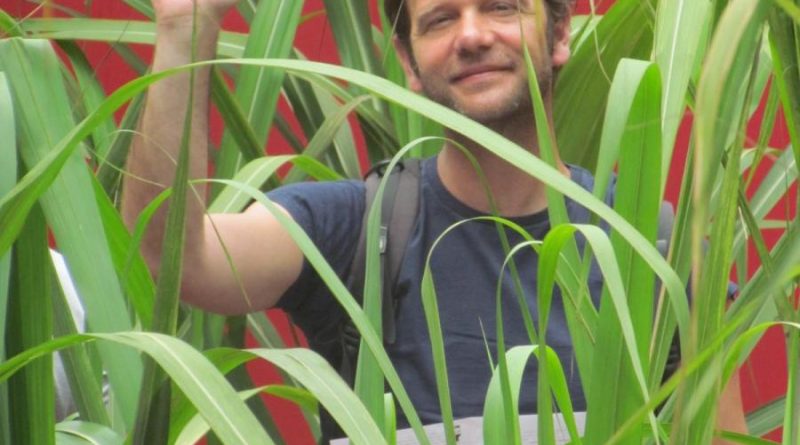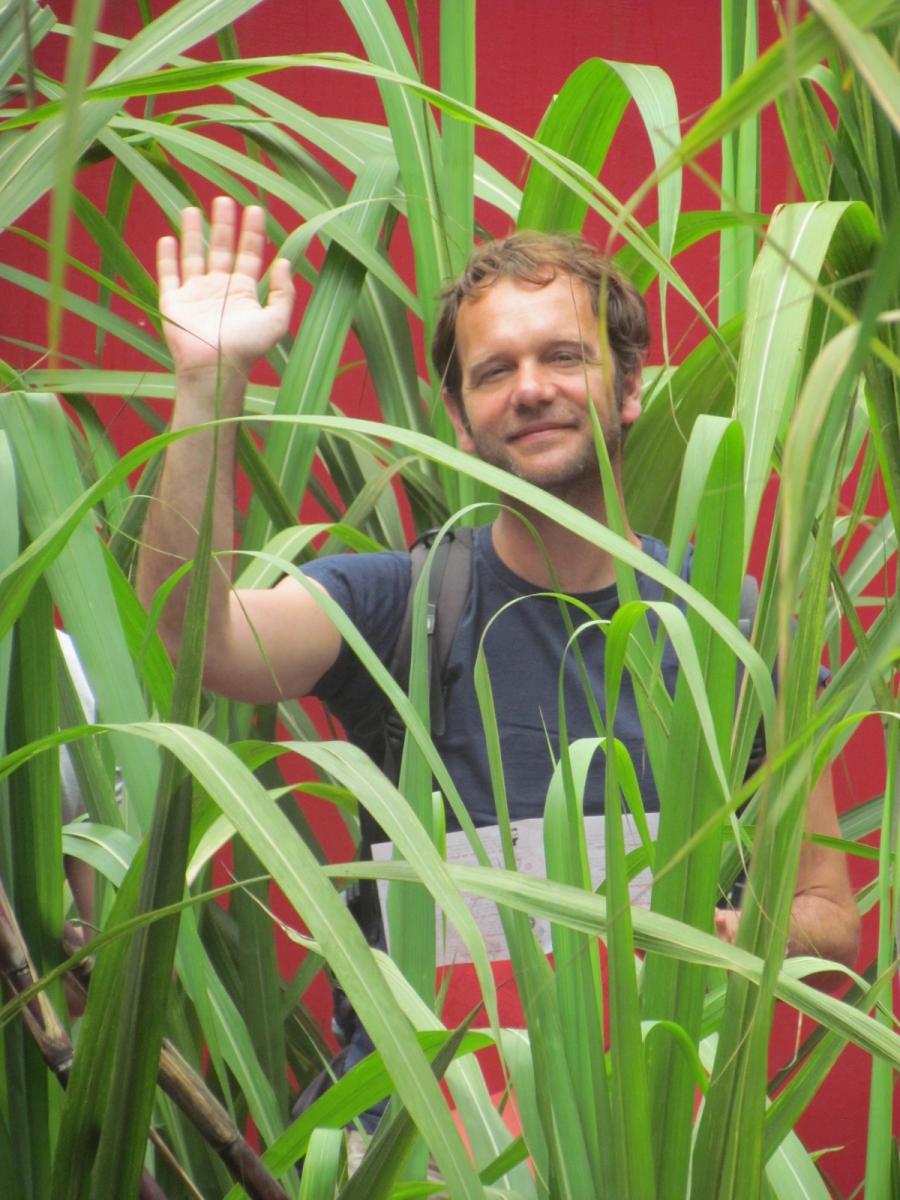
Jean-François Arnaud
Jean-François Arnaud
Professeur
Equipe Evo-Eco
Group : Evolutionary ecology and genetics across different scales 
Unité Evo-Eco-Paléo (EEP) – UMR 8198
CNRS / Université de Lille – Sciences et Technologies
Batiment SN2, bureau 209
59655 Villeneuve d’Ascq – FRANCE
Tel : 33 (0)3-20-33-62-96
Mail : Jean-Francois.Arnaud@univ-lille.fr
Teaching:
- Population genetics
- Evolutionary biology
- Quantitative genetics
- Ecological genetics
- Behavioural ecology
Brief CV:
2011-current: Professor, University of Lille, Sciences & Technologies, UMR CNRS 8198
2008-2010: Délégation C.N.R.S. (full-time research scientist during the 2008-2010 academic years)
2008: Habilitation à Diriger des Recherches (Specific French diploma allowing to supervise PhD students)
2002-2011: Assistant Professor (Maître de Conférences), University of Lille 1, UMR CNRS 8198
2001-2002: Junior lecturer (A.T.E.R.), University of Lille 1, UMR CNRS 8198
2000-2001: Junior lecturer (A.T.E.R.), University of Rennes 1, UMR CNRS ECOBIO
1997-2000: PhD Thesis supervised by Luc Madec, University of Rennes 1, UMR CNRS ECOBIO
Research activities:
My research interest focuses on the evolution of mating system and on population genetics in spatially subdivided populations with both evolutionary and conservation concerns. My broad field study areas can be subdivided as follows:
(1) Human activities impact microevolutionary dynamics through environmental changes and habitat destruction is currently acknowledged as one of the major drivers of biodiversity loss. Anthropic activities inducing land use change are by far the most important contemporary cause of native habitat loss and landscape fragmentation. Loss of habitats and isolation of populations may lead to a decrease of levels of gene flow among populations and to the reduction of effective population size. Isolated populations facing disturbed human-made habitats are therefore extremely vulnerable due to a decrease of gene diversity and the associated loss of adaptive capability. However, it also appears that new anthropic habitats may benefit to the successful establishment of pioneering species in highly disturbed areas. In this respect, my research activities aim to (i) assess the landscape components driving the level and extent of gene flow among remnant populations and (ii) understand which new anthropic habitats can be colonized and can shelter viable populations exchanging substantial levels of gene flow to prevent the eroding effect of genetic drift. To this end, I used various organisms as model study (e.g. hydrochorous wetland plants, land snails, amphibians).
(2) Investigating the spatial genetic structure of plant populations has important implications for the management and conservation of genetic resources, as well as for biosafety studies like the assessment of transgenes escape in the wild. In this regard, one topic of my research activities deals with the interactions between cultivated beets and their wild relatives in terms of crop-to-wild gene flow through seed and pollen dispersal events.
(3) Crop-wild intraspecific hybridizations between genetically differentiated lineages are also a source of evolutionary novelty that may provide opportunities for invasive success in agricultural weeds. To gain insights into how weed populations can evolve rapidly in response to novel and changing environments, I investigate the evolution of mating system in invasive crop-wild hybrids: weed beets. The two key reproductive parameters involved in the successful spread of weed beets are (i) a first-year flowering that arise by introgression of a wild genetic background into the crop gene pool and (ii) a crop-derived gene that offsets self-incompatibility.
(4) The last part of my research activities deals with the evolution of a particular breeding system: gynodioecy. Gynodioecy is a gender polymorphism that refers to plant species in which females and hermaphrodites coexist in natural populations. Bringing together studies of nucleo-cytoplasmic genetic diversity, direct measures of male fitness and a detailed description of the occurrence of cytoplasmic male sterility in wild populations, I study the interplay between patterns of gene flow through seed and pollen dispersal and the evolution of sex ratio in structured populations.
Publications:
- Latron, M., Arnaud, J.-F., Ferla, H., Godé, C. & Duputié, A. (2019) Effects of contemporary shifts of range margins on patterns of genetic structure and mating system in two coastal plant species. Heredity, 123, sous presse (doi: 10.1038/s41437-019-0269-0).

- Latron, M., Arnaud, J.-F., Ferla, H., Godé, C. & Duputié, A. (2018) Polymorphic nuclear markers for coastal plant species with dynamic geographic distributions, the rock samphire (Crithmum maritimum) and the vulnerable dune pansy (Viola tricolor subsp. curtisii). Molecular Biology Reports, 45, 203-209. (download)
- Faucher, L., Hénocq, L., Vanappelghem, C., Rondel, S., Quevillart, R., Gallina, S., Godé, C., Jaquiéry, J. & Arnaud, J.-F. (2017) When new human-modified habitats favor the expansion of an amphibian pioneer species: evolutionary history of the natterjack toad (Bufo calamita) in a coal basin. Molecular Ecology, 26, 4434-4451.

- Faucher, L., Godé, C. & Arnaud, J.-F. (2016) Development of nuclear microsatellite loci and mitochondrial single nucleotide polymorphisms for the Natterjack Toad, Bufo (Epidalea) calamita (Bufonidae), using next generation sequencing and competitive allele specific PCR (KASPar). Journal of Heredity, 107, 660-665.

- Gracianne, C., Jan, P.-L., Fournet, S., Olivier, E., Arnaud, J.-F., Porte, C., Bardou-Valette, S., Denis, M.-C., Petit, E.J. (2016) Temporal sampling helps unravel the genetic structure of naturally occurring populations of a phytoparasitic nematode. 2 Disentangling the relative effects of gene flow and genetic drift. Evolutionary Applications, 9, 1005-1016.

- Jan, P.-L., Gracianne, C., Fournet, S., Olivier, E., Arnaud, J.-F., Porte, C., Bardou-Valette, S., Denis, M.-C., Petit, E.J. (2016) Temporal sampling helps unravel the genetic structure of naturally occurring populations of a phytoparasitic nematode. 1 Insights from the estimation of effective population sizes. Evolutionary Applications, 9, 489-501.

- Martin, H., Touzet, P., Van Rossum, F., Delalande, D. & Arnaud, J.-F. (2016) Phylogeographic pattern of range expansion provides evidence for cryptic species lineages in Silene nutans in Western Europe. Heredity, 116, 286-294.

- Favre-Bac, L., Mony, C., Ernoult, A., Burel, F. & Arnaud, J.-F. (2016) Ditch network sustains functional connectivity and influences patterns of gene flow in an intensive agricultural landscape. Heredity, 116, 200-212.

- Faucher, L., Hénocq, L., Vanappelghem, C., Rondel, S., Quevillart, R., Godé, C. & Arnaud, J.-F. (2016) Genetic structure of native and newly founded populations of the Natterjack Toad (Bufo calamita) in northern France. Herpetological Journal, 26, 2-2.
- Poux, C., Gothland, M., Holl, A.-C., Spilmont, N. & Arnaud, J.-F. (2015) Highly polymorphic microsatellite markers in two species, the invasive shore crabs Hemigrapsus sanguineus and Hemigrapsus takanoi (Decapoda, Varunidae). Conservation Genetics Ressources, 7, 569-572.

- Favre-Bac, L., Godé, C. & Arnaud, J.-F. (2014) Characterization of polymorphic microsatellite markers for the fine-leaved water-Dropwort Oenanthe aquatica and the Gypsywort Lycopus europaeus, two farmland remnant wetland species. Conservation Genetics Ressources, 6, 995-998.

- Godé, C., Touzet, P., Martin, H., Lahiani, E., Delph, L. F. & Arnaud, J.-F. (2014) Characterization of 24 polymorphic microsatellite markers for Silene nutans, a gynodioecious-gynomonoeicous species, and cross-species amplification in Silene species. Conservation Genetics Ressources, 6, 915-918.

- Gracianne, C., Petit, E. J., Arnaud, J.-F., Rouaux, C., Renault, L., Fouville, D., Porte, C. & Fournet, S. (2014) Spatial distribution and basic ecology of Heterodera schachtii and H. betae wild populations developing on sea beet, Beta vulgaris ssp. maritima. Nematology, 16, 797-805.

- Leys, M., Petit, E. J., El-Bahloul, Y., Liso, C., Fournet, S. & Arnaud, J.-F. (2014) Spatial genetic structure in Beta vulgaris subsp. maritima and Beta macrocarpa reveals the effect of contrasting mating system, influence of marine currents, and footprints of postglacial recolonization routes. Ecology and Evolution, 4, 1828-1852.

- De Cauwer, I., Arnaud, J.-F., Klein, E. K. & Dufaÿ, M. (2012) Disentangling the causes of heterogeneity in male fecundity in gynodioecious Beta vulgaris ssp. maritima. New Phytologist, 195, 676-687.

- De Cauwer, I., Dufaÿ, M., Hornoy, B., Courseaux, A. & Arnaud, J.-F. (2012) Gynodioecy in structured populations: understanding fine-scale sex ratio variation in Beta vulgaris ssp. maritima. Molecular Ecology, 21, 834-850.

- Arnaud, J.-F., Cuguen, J. & Fénart, S. (2011) Metapopulation structure and fine-scaled genetic structuring in crop-wild hybrid weed beets. Heredity, 107, 395-404.

- De Cauwer, I., Arnaud, J.-F., Courseaux, A. & Dufaÿ, M. (2011) Sex-specific fitness variation in gynodioecious Beta vulgaris ssp. maritima: do empirical observations fit theoretical predictions? Journal of Evolutionary Biology, 24, 2456-2472.

- De Cauwer, I., Arnaud, J.-F., Schmitt, E. & Dufaÿ, M. (2010) Pollen limitation of female reproductive success at fine spatial scale in a gynodioecious and wind-pollinated species, Beta vulgaris ssp. maritima. Journal of Evolutionary Biology, 23, 2636-2647.

- Arnaud, J.-F., Fénart, S., Cordellier, M. & Cuguen, J. (2010) Populations of weedy crop-wild hybrid beets show contrasting variation in mating system and population genetic structure. Evolutionary Applications, 3, 305-318.

- De Cauwer, I., Dufaÿ, M., Cuguen, J. & Arnaud, J.-F. (2010) Effects of fine-scale genetic structure on male mating success in gynodioecious Beta vulgaris ssp. maritima. Molecular Ecology, 19, 1540-1558.
 (Article featured in the section “News and Views” of the same journal issue).
(Article featured in the section “News and Views” of the same journal issue). - Arnaud, J.-F., Fénart, S., Godé, C., Deledicque, S., Touzet, P. & Cuguen, J. (2009) Fine-scale geographical structure of genetic diversity in inland wild beet populations. Molecular Ecology, 18, 3201-3215.

- Dufaÿ, M., Cuguen, J., Arnaud, J.-F. & Touzet, P. (2009) Sex ratio variation among gynodioecious populations of sea beet: can it be explained by negative frequency-dependent selection? Evolution, 63, 1483-1497.

- Fénart, S., Arnaud, J.-F., De Cauwer, I. & Cuguen, J. (2008) Nuclear and cytoplasmic genetic diversity in weed beet and sugar beet accessions compared to wild relatives: new insights into the genetic relationships within the Beta vulgaris complex species. Theoretical and Applied Genetics, 116, 1063-1077.

- Dufaÿ, M., Vaudey, V., De Cauwer, I., Touzet, P., Cuguen, J. & Arnaud, J.-F. (2008) Variation in pollen production and pollen viability in natural populations of gynodioecious Beta vulgaris ssp. maritima: evidence for a cost of restoration of male function? Journal of Evolutionary Biology, 21, 202-212.

- Fénart, S., Austerlitz, F., Cuguen, J. & Arnaud, J.-F. (2007) Long distance pollen-mediated gene flow at a landscape level: the weed beet as a case study. Molecular Ecology, 16, 3801-3813.

- Fievet, V., Touzet, P., Arnaud, J.-F. & Cuguen, J. (2007) Spatial analysis of nuclear and cytoplasmic DNA diversity in wild sea beet (Beta vulgaris ssp. maritima) populations: do marine currents shape the genetic structure? Molecular Ecology, 16, 1847-1864.

- Fénart, S., Touzet, P., Arnaud, J.-F. & Cuguen, J. (2006) Emergence of gynodioecy in wild beet (Beta vulgaris ssp. maritima L.): a genealogical approach using chloroplastic nucleotide sequences. Proceedings of the Royal Society of London B, 273, 1391-1398.

- Evanno, G., Madec, L. & Arnaud, J.-F. (2005) Multiple paternity and post-copulatory sexual selection in a hermaphrodite: what influences sperm precedence in the garden snail Helix aspersa? Molecular Ecology, 14, 805-812.

- Cuguen, J., Arnaud, J.-F., Delescluse, M. & Viard, F. (2005) Gene flow within the Beta species complex: genetic diversity of weed and wild sea beet populations within the French sugar beet production area. In Advances in Sugar beet Research, vol. 6 (ed. J. Pidgeon, M. M. Molard, J. D. A. Wevers & R. Beckers), pp. 103-115. Brussels, Belgium: International Institute for Beet Research.
- Arnaud, J.-F. & Laval, G. (2004) Stability of genetic structure and effective population size inferred from temporal changes of microsatellite DNA polymorphisms in the land snail Helix aspersa (Gastropoda: Helicidae). Biological Journal of the Linnean Society, 82, 89-102.

- Viard, F., Arnaud, J.-F., Delescluse, M. & Cuguen, J. (2004) Tracing back seed and pollen flow within the crop-wild Beta vulgaris complex: genetic distinctiveness versus hot spots of hybridization over a regional scale. Molecular Ecology, 13, 1357-1364.

- Cuguen, J., Arnaud, J.-F., Delescluse, M. & Viard, F. (2004) Crop-wild interaction within the Beta vulgaris complex: a comparative analysis of genetic diversity between sea beet and weed beet populations within the french sugarbeet production area. In Introgression from Genetically Modified Plants into Wild Relatives (ed. H. C. M. Den Nijs, D. Bartsch & J. Sweet), pp. 183-201. The Netherlands: CABI Publishers, Inc.
- Arnaud, J.-F., Viard, F., Delescluse, M. & Cuguen, J. (2003) Evidence for gene flow via seed dispersal from crop to wild relatives in Beta vulgaris (Chenopodiaceae): consequences for the release of genetically modified crop species with weedy lineages. Proceedings of the Royal Society of London, Series B, 270, 1565-1571.

- Arnaud, J.-F., Madec, L., Guiller, A. & Deunff, J. (2003) Population genetic structure in a human-disturbed environment: a case study in the land snail Helix aspersa (Gastropoda: Pulmonata). Heredity, 90, 451-458.

- Arnaud, J.-F. (2003) Metapopulation genetic structure and migration pathways in the land snail Helix aspersa: influence of landscape heterogeneity. Landscape Ecology, 18, 333-346.

- Bellido, A., Madec, L., Arnaud, J.-F. & Guiller, A. (2002) Spatial structure of shell polychromatism in populations of Cepaea nemoralis: new techniques for an old debate. Heredity, 88, 75-82.

- Arnaud, J.-F., Madec, L., Guiller, A. & Bellido, A. (2001) Spatial analysis of allozyme and microsatellite DNA polymorphisms in the land snail Helix aspersa (Gastropoda: Helicidae). Molecular Ecology, 10, 1563-1576.

- Guiller, A., Arnaud, J.-F., Vautrin, D. & Solignac, M. (2000) Highly polymorphic microsatellite markers in the landsnail Helix aspersa (Mollusca: Gastropoda). Molecular Ecology, 9, 1191-1193.

- Arnaud, J.-F., Madec, L., Bellido, A. & Guiller, A. (1999) Microspatial genetic structure in the land snail Helix aspersa (Gastropoda: Helicidae). Heredity, 83, 110-119.

- Arnaud, J.-F., Madec, L. & Daguzan, J. (1999) Spatial differentiation of allozyme frequencies in a subdivided population of the land snail Helix aspersa. Journal of Molluscan Studies, 65, 267-271.



